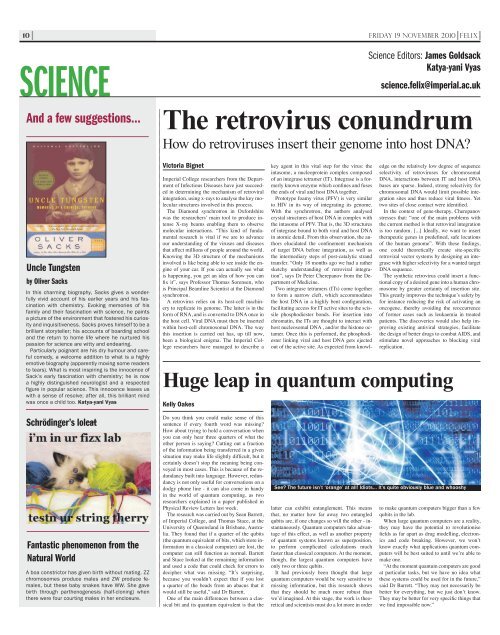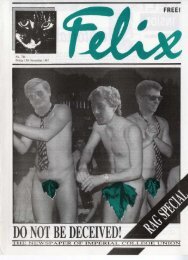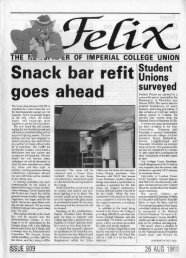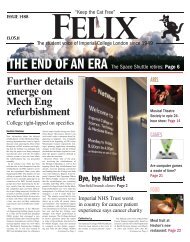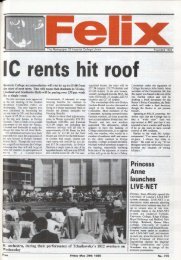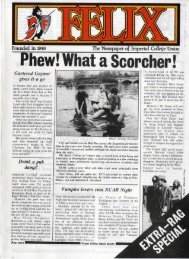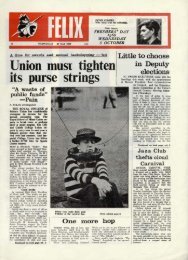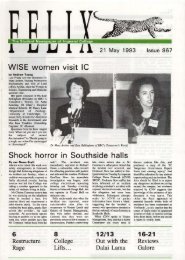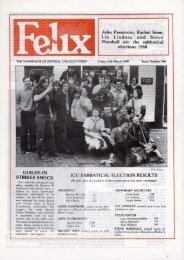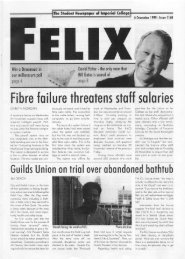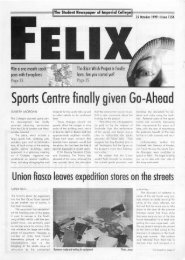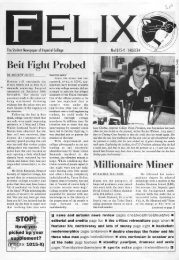1 - 9 News.indd - Felix
1 - 9 News.indd - Felix
1 - 9 News.indd - Felix
Create successful ePaper yourself
Turn your PDF publications into a flip-book with our unique Google optimized e-Paper software.
10<br />
SCIENCE<br />
And a few suggestions...<br />
Uncle Tungsten<br />
by Oliver Sacks<br />
In this charming biography, Sacks gives a wonderfully<br />
vivid account of his earlier years and his fascination<br />
with chemistry. Evoking memories of his<br />
family and their fascination with science, he paints<br />
a picture of the environment that fostered his curiosity<br />
and inquisitiveness. Sacks proves himself to be a<br />
brilliant storyteller; his accounts of boarding school<br />
and the return to home life where he nurtured his<br />
passion for science are witty and endearing.<br />
Particularly poignant are his dry humour and careful<br />
comedy, a welcome addition to what is a highly<br />
emotive biography (apparently moving some readers<br />
to tears). What is most inspiring is the innocence of<br />
Sack’s early fascination with chemistry; he is now<br />
a highly distinguished neurologist and a respected<br />
figure in popular science. This innocence leaves us<br />
with a sense of resolve; after all, this brilliant mind<br />
was once a child too. Katya-yani Vyas<br />
Schrödinger’s lolcat<br />
Fantastic phenomenon from the<br />
Natural World<br />
A boa constrictor has given birth without mating. ZZ<br />
chromosomes produce males and ZW produce females,<br />
but these baby snakes have WW. She gave<br />
birth through parthenogenesis (half-cloning) when<br />
there were four courting males in her enclosure.<br />
FELIX<br />
Science Editors: James Goldsack<br />
Katya-yani Vyas<br />
science.felix@imperial.ac.uk<br />
The retrovirus conundrum<br />
How do retroviruses insert their genome into host DNA?<br />
Victoria Bignet<br />
Imperial College researchers from the Department<br />
of Infectious Diseases have just succeeded<br />
in determining the mechanism of retroviral<br />
integration, using x-rays to analyse the key molecular<br />
structures involved in this process.<br />
The Diamond synchrotron in Oxfordshire<br />
was the researchers’ main tool to produce intense<br />
X-ray beams enabling them to observe<br />
molecular interactions. “This kind of fundamental<br />
research is vital if we are to advance<br />
our understanding of the viruses and diseases<br />
that affect millions of people around the world.<br />
Knowing the 3D structure of the mechanisms<br />
involved is like being able to see inside the engine<br />
of your car. If you can actually see what<br />
is happening, you get an idea of how you can<br />
fi x it”, says Professor Thomas Sorensen, who<br />
is Principal Beamline Scientist at the Diamond<br />
synchrotron.<br />
A retrovirus relies on its host-cell machinery<br />
to replicate its genome. The latter is in the<br />
form of RNA, and is converted to DNA once in<br />
the host cell. Viral DNA must then be inserted<br />
within host-cell chromosomal DNA. The way<br />
this insertion is carried out has, up till now,<br />
been a biological enigma. The Imperial College<br />
researchers have managed to describe a<br />
key agent in this vital step for the virus: the<br />
intasome, a nucleoprotein complex composed<br />
of an integrase tetramer (IT). Integrase is a formerly<br />
known enzyme which confi nes and fuses<br />
the ends of viral and host DNA together.<br />
Prototype foamy virus (PFV) is very similar<br />
to HIV in its way of integrating its genome.<br />
With the synchrotron, the authors analysed<br />
crystal structures of host DNA in complex with<br />
the intasome of PFV. That is, the 3D structures<br />
of integrase bound to both viral and host DNA<br />
in atomic detail. From this observation, the authors<br />
elucidated the confi nement mechanism<br />
of target DNA before integration, as well as<br />
the intermediary steps of post-catalytic strand<br />
transfer. “Only 18 months ago we had a rather<br />
sketchy understanding of retroviral integration”,<br />
says Dr Peter Cherepanov from the Department<br />
of Medicine.<br />
Two integrase tetramers (ITs) come together<br />
to form a narrow cleft, which accommodates<br />
the host DNA in a highly bent confi guration,<br />
facilitating access for IT active sites to the scissile<br />
phosphodiester bonds. For insertion into<br />
chromatin, the ITs are thought to interact with<br />
host nucleosomal DNA , and/or the histone octamer.<br />
Once this is performed, the phosphodiester<br />
linking viral and host DNA gets ejected<br />
out of the active site. As expected from knowl-<br />
edge on the relatively low degree of sequence<br />
selectivity of retroviruses for chromosomal<br />
DNA, interactions between IT and host DNA<br />
bases are sparse. Indeed, strong selectivity for<br />
chromosomal DNA would limit possible integration<br />
sites and thus reduce viral fi tness. Yet<br />
two sites of close contact were identifi ed.<br />
In the context of gene-therapy, Cherepanov<br />
stresses that: “one of the main problems with<br />
the current method is that retroviral integration<br />
is too random. [...] Ideally, we want to insert<br />
therapeutic genes in predefi ned, safe locations<br />
of the human genome”. With these fi ndings,<br />
one could theoretically create site-specifi c<br />
retroviral vector systems by designing an integrase<br />
with higher selectivity for a wanted target<br />
DNA sequence.<br />
The synthetic retrovirus could insert a functional<br />
copy of a desired gene into a human chromosome<br />
by greater certainty of insertion site.<br />
This greatly improves the technique’s safety by<br />
for instance reducing the risk of activating an<br />
oncogene, thereby avoiding the reoccurrence<br />
of former cases such as leukaemia in treated<br />
patients. The discoveries would also help improving<br />
existing antiviral strategies, facilitate<br />
the design of better drugs to combat AIDS, and<br />
stimulate novel approaches to blocking viral<br />
replication.<br />
Huge leap in quantum computing<br />
Kelly Oakes<br />
Do you think you could make sense of this<br />
sentence if every fourth word was missing?<br />
How about trying to hold a conversation when<br />
you can only hear three quarters of what the<br />
other person is saying? Cutting out a fraction<br />
of the information being transferred in a given<br />
situation may make life slightly diffi cult, but it<br />
certainly doesn’t stop the meaning being conveyed<br />
in most cases. This is because of the redundancy<br />
built into language. However, redundancy<br />
is not only useful for conversations on a<br />
dodgy phone line - it can also come in handy<br />
in the world of quantum computing, as two<br />
researchers explained in a paper published in<br />
Physical Review Letters last week.<br />
The research was carried out by Sean Barrett,<br />
of Imperial College, and Thomas Stace, at the<br />
University of Queensland in Brisbane, Australia.<br />
They found that if a quarter of the qubits<br />
(the quantum equivalent of bits, which store information<br />
in a classical computer) are lost, the<br />
computer can still function as normal. Barrett<br />
and Stace looked at the remaining information<br />
and used a code that could check for errors to<br />
decipher what was missing. “It’s surprising,<br />
because you wouldn’t expect that if you lost<br />
a quarter of the beads from an abacus that it<br />
would still be useful,” said Dr Barrett.<br />
One of the main differences between a classical<br />
bit and its quantum equivalent is that the<br />
latter can exhibit entanglement. This means<br />
that, no matter how far away two entangled<br />
qubits are, if one changes so will the other - instantaneously.<br />
Quantum computers take advantage<br />
of this effect, as well as another property<br />
of quantum systems known as superposition,<br />
to perform complicated calculations much<br />
faster than classical computers. At the moment,<br />
though, the largest quantum computers have<br />
only two or three qubits.<br />
It had previously been thought that large<br />
quantum computers would be very sensitive to<br />
missing information, but this research shows<br />
that they should be much more robust than<br />
we’d imagined. At this stage, the work is theoretical<br />
and scientists must do a lot more in order<br />
Friday 19 November 2010<br />
See? The future isn’t ‘orange’ at all! Idiots... It’s quite obviously blue and whooshy<br />
to make quantum computers bigger than a few<br />
qubits in the lab.<br />
When large quantum computers are a reality,<br />
they may have the potential to revolutionise<br />
fi elds as far apart as drug modelling, electronics<br />
and code breaking. However, we won’t<br />
know exactly what applications quantum computers<br />
will be best suited to until we’re able to<br />
make one.<br />
“At the moment quantum computers are good<br />
at particular tasks, but we have no idea what<br />
these systems could be used for in the future,”<br />
said Dr Barrett. “They may not necessarily be<br />
better for everything, but we just don’t know.<br />
They may be better for very specifi c things that<br />
we fi nd impossible now.”


